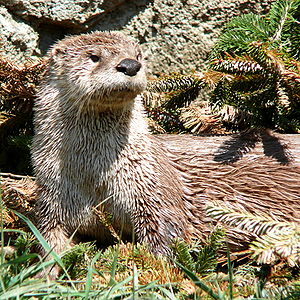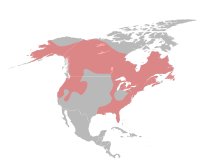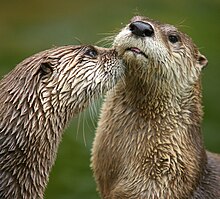North American river otter
| North American river otter | ||||||||||||
|---|---|---|---|---|---|---|---|---|---|---|---|---|

North American river otter |
||||||||||||
| Systematics | ||||||||||||
|
||||||||||||
| Scientific name | ||||||||||||
| Lontra canadensis | ||||||||||||
| ( Schreber , 1777) |
The North American otter ( Lontra canadensis ) is a marten belonging to the New World otter genus . It is only found in North America.
description
Like all otters, the North American otter has a slender, elongated body with short legs. The tail is slightly flattened dorsoventrally. Male North American otters reach a head body length of about 70 cm and a body weight of 7.7 to 9.4 kg, while the females with 60–70 cm head body length and 7.3–8.4 kg are usually somewhat smaller and lighter. The tail length is 32–47 cm. The color of the thick coat varies from brown to blackish on top, while the throat, chin and chest area are greyish. The nasal mirror is bare, the feet are webbed and have short claws.
The dentition consists of 36 teeth and has the following tooth formula:
Distribution area and habitat
The North American river otter lives in large parts of North America from Alaska and Canada in the north to Florida and the southwestern United States. In this area it occurs in the area of rivers, ponds, lakes and salt marshes along the coast of the sea. As a rule, he prefers waters with dense bank vegetation. The population density varies, depending on the region, from about one animal per four square kilometers in Idaho to one animal per 1.25 square kilometers in the coastal areas of Alaska.
Subspecies
A distinction is made between the following subspecies of the North American otter:
- L. c. canadensis : Eastern Canada ( Maritime Provinces , Ontario and Québec )
- L. c. kodiacensis : Kodiak Island and Shuyak Island in Alaska
- L. c. lataxina : Eastern United States
- L. c. mira : Prince of Wales Island (Alaska) , Vancouver Island
- L. c. pacifica : Western Canada and Western United States
- L. c. periclyzomae : Haida Gwaii
- L. c. sonora : Southwestern United States, Mexico
Hunting style and diet
The species feeds primarily on fish, but also eats amphibians, crustaceans, rodents, molluscs, small reptiles and birds. Sometimes fruits are also consumed. Among the fish, he prefers slow-swimming species over fast-swimming species. The population density of the otter usually depends on the abundance of fish in the habitat. The North American otter hunts in murky waters by touching fish with its vibrissae . In clear waters he hunts by sight. The otter is an excellent swimmer and diver who can stay underwater for up to four minutes and swims up to 11 km / h. Occasionally, these otters also hunt in groups to corner fish. The North American river otter is mostly active at night or at dusk. In the winter months you can see the animals more often during the day. They do not hibernate and also chase the fish under the ice cover.
Behavior and way of life
North American otters are extremely mobile and often travel long distances. Daily distances of up to 40 kilometers have been described. On their daily forays, males cover an average of four to five kilometers, females two to three kilometers. Mostly they move in the water, but they also cover larger distances over land, mostly between waterways that are apart. They rest in caves in embankments, which are often created by beavers. Often these hiding places have an entrance below the surface of the water.
Social behavior is quite complex and differentiated depending on the region. They often live together in groups of up to 15 animals, with the largest groups being found along the coast of the sea. In the coastal areas, the large groups consist on the one hand of females with their offspring and on the other hand of males. The male groups disintegrate during the mating season when each of them tries to conquer a female group.
Reproduction
The mating season in the northern parts of the area is in April, while in the southern parts of the distribution area it takes place in December. The implantation of the embryos in the uterus is delayed and only takes place after a dormancy of at least eight months. Since the actual embryonic development takes 61 to 63 days, the young are born after more than 10 months in winter to spring next year. The total gestation period including dormancy is 290 to 380 days. The populations in southern Florida do not seem to go through this delayed implantation of the embryo. A litter consists of one to five blind, toothless boys and is born in a cave near the water. However, this does not have to be directly on the water. The young are weaned at twelve weeks of age and sexually mature themselves at around two years of age. The males do not take part in the rearing of the young.
Duration
The North American river otter is not considered endangered. However, the subspecies L. c. sonora in Mexico may be threatened. The greatest dangers are water pollution, especially when fish stocks suffer. The moderate removal of North American otters for fur production, which takes place in many places, does not seem to affect the populations as long as the habitats are intact. In some areas where the species had already disappeared, it has been successfully reintroduced.
literature
- Larivière, S. & Jennings, AP (2009). Family Mustelidae (Weasels and Relatives) . In: Wilson, DE, Mittermeier, RA, (Eds.). Handbook of the Mammals of the World . Volume 1: Carnivores. Lynx Edicions, 2009, ISBN 978-84-96553-49-1
- Ronald M. Nowak: Walker's Mammals of the World . Johns Hopkins University Press, 1999, ISBN 0-8018-5789-9
Individual evidence
Web links
- Lontra canadensis inthe IUCN 2013 Red List of Threatened Species . Posted by: Serfass, T. & Polechla, P., 2008. Retrieved December 29, 2013.






